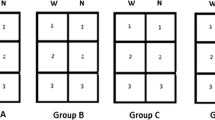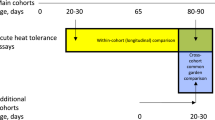Abstract
Poikilothermic organisms accumulate highly unsturated FA (HUFA) in their lipids at reduced temperatures to maintain cell membrane fluidity. In this study we investigated the effect of temperature on temporal trajectories of FA of fasting Daphnia pulex cultured on a HUFA-free diet. Daphnia pulex populations were maintained for 1 mon at 22 and 11°C and were fed the chlorophyte Ankistrodesmus falcatus. We observed conversion of C18 FA precursors to EPA (20∶5n3) and arachidonic acid (ARA; 20∶4n6) in D. pulex. We showed that long-term exposure to cold temperature causes a significant increase in EPA, HUFA such as ARA and EPA are highly conserved during starvation. Therefore, D. pulex has the biosynthetic capacity to adjust and to maintain the content of HUFA required to survive at low temperatures.
Similar content being viewed by others
Abbreviations
- AF:
-
Ankistrodesmus falcatus
- ALA:
-
α-linolenic acid
- ARA:
-
arachidonic acid
- DA11:
-
Daphia pulex cultured at 11°C
- DA22:
-
Daphnia pulex cultured at 22°C
- HUFA:
-
Highly unsaturated FA
- LIN:
-
linoleic acid
- MUFA:
-
monounsaturated FA
- TFA:
-
total FA content
References
Pennak, R.W. (1989) Freshwater Invertebrates of the United States, 3rd edn., John Wiley & Sons, New York.
Goss, L.B., and Bunting, D.L. (1983) Daphnia Development and Reproduction: Responses to Temperature. J. Therm. Biol. 8, 375–380.
Pruitt, N.L. (1990) Adaptations to Temperature in the Cellular Membranes of Crustacean: Membrane Structure and Metabolism, J. Therm. Biol. 15, 1–8.
Hazel, J.R., and Williams, E.E. (1990) The Role of Alterations in Membrane Lipid Composition in Enabling Physiological Adaptation of Organisms to Their Physical Environment, Prog. Lipid Res., 29, 167–227.
Sargent, J.R., Tocher, D.R., and Bell, J.G. (2002) The Lipids, in Fish Nutrition, Halver, J.E., and Hardy, R.W., eds., pp. 181–257, Academic Press, San Diego.
Von Elert, E. (2002) Determination of Limiting Polyunsaturated Fatty Acids in Daphnia galeata Using a New Method to Enrich Food Algae with Single Fatty Acids, Limnol. Oceanogr. 47, 1764–1773.
Becker, C., and Boersma, M. (2005) Differential Effects of Phosphorus and Fatty Acids on Daphnia, Growth and Reproduction, Limnol. Oceanogr. 50, 388–397.
Farkas, T. (1979) Adaptation of Fatty Acid Compositions to Temperature—A Study on Planktonic Crustaceans, Comp. Biochem. Physiol., 64B, 71–76.
Farkas, T., Kariko, K., and Csengeri, I. (1981) Incorporation of [1-14C]Acetate into Fatty Acids of the Crustaceans Daphnia magna and Cyclops strenus in Relation to Temperature, Lipids 16, 418–422.
Stanley-Samuelson, D.W. (1994) Prostaglandins and Related Eicosanoids in Insects, Adv. Insect Physiol. 24, 115–212.
Goulden, C.E., and Place, A.R. (1990) Fatty Acid Synthesis and Accumulation Rates in Daphniids, J. Exp. Zool. 256, 168–178.
Bychek, E.A., Dobson, G.A., Harwood, J.L., and Guschina, I.A. (2005) Daphnia magna Can Tolerate Short-Term Starvation Without Major Changes in Lipid Metabolism, Lipids 40, 599–608.
Stein, J. (1973) Handbook of Phycological Methods. Culture Methods and Growth Measurements, Cambridge University Press, Cambridge.
Elendt, B.P. (1989) Effects of Starvation on Growth, Reproduction, Survival and Biochemical Composition of Daphnia magna, Arch. Hydrobiol. 116, 415–433.
Bligh, E.G., and Dyer, W.J. (1959) A Rapid, Method of Total Lipid Extraction and Purification, Can. J. Biochem. Physiol. 37, 911–917
Sokal, R.R., and Rohlf, F.J. (1995) Biometry, 3rd edn., W.H. Freeman, New York.
DeMott, W.R., and Müller-Navarra, D.C. (1997) The Importance of Highly Unsaturated Fatty Acids in Zooplankton Nutrition: Evidence from Experiments with Daphnia, a Cyanobacterium and Lipid Emulsions, Freshwater Biol. 38, 649–664.
Sundbom, M., and Vrede, T. (1997), Effects of Fatty Acid and Phosphorus Content of Food on the Growth, Survival and Reproduction of Daphnia, Freshwater Biol. 38, 665–674.
Klein Breteler, W.C.M., Schogt, N., Baas, M., Schouten, S., and Kraay, G.W. (1999) Trophic Upgrading of Food Quality by Protozoans Enhancing Copepod Growth: Role of Essential Lipids, Mar. Biol. 135, 191–198.
Tiku, P.E., Gracey, A.Y., Macartney, A.I., Beynon, R.J., and Cossins, A.R. (1996) Cold Induced Expression of Δ9-Desaturase in Carp by Transcriptional and Post-translational Mechanisms, Science 271, 815–818.
Gunstone, F.D., Harwood, J.L., and Padley, F.B. (1986) The Lipid Handbook, Chapman and Hall, London.
Peters, R.H. (1987) Metabolism in Daphnia, in Daphnia (Peters, R.H., and de Bernardi, R., eds.) Vol. 45, pp. 193–243, Memoirie dell'Instituto Italiano de Idrobiologia, Verbania, Pallanza.
Schmidt-Nielsen, K. (1997) Animal Physiology—Adaptation and Environment, 5th edn., Cambridge University Press, Cambridge.
Kainz, M., Arts, M.T., and Mazumder, A. (2004) Essential Fatty Acids in the Planktonic, Food Web and Their Ecological Role for Higher Trophic Levels, Limnol. Oceanogr. 49, 1784–1793.
Threlkeld, S.T. (1976) Starvation and the Size Structure of Zooplankton Communities, Freshwater Biol. 6, 489–96.
Tessier, A.J., Henry, L.L., Goulden, C.E., Durand, M.W., (1983) Starvation in Daphnia: Energy Researves and Reproductive Allocation, Limnol. Oceanogr. 28, 667–676.
Johnson, G.H., and Jacobsen, P.J. (1987) The Effect of Food Limitation on Vertical Migration in Daphnia longispina, Limnol. Oceanogr. 32, 873–880.
Lemcke, H.W., and Lampert, W. (1975) Veränderungen im Gewicht und der chemischen Zusammensetzung von Daphnia pulex im Hunger, Arch. Hydrobiol. Suppl. 48, 108–137.
Dalsgaard, J.M., John, M.S., Kattner, G., Mueller-Navarra, D.C., and Hagen, W. (2003) Fatty Acid Trophic Markers in the Pelagic Marine Food Environment, Adv. Mar. Biol. 46, 226–340.
Author information
Authors and Affiliations
Corresponding author
About this article
Cite this article
Schlechtriem, C., Arts, M.T. & Zellmer, I.D. Effect of temperature on the fatty acid composition and temporal trajectories of fatty acids in fasting Daphnia pulex (Crustacea, cladocera). Lipids 41, 397–400 (2006). https://doi.org/10.1007/s11745-006-5111-9
Received:
Accepted:
Issue Date:
DOI: https://doi.org/10.1007/s11745-006-5111-9




